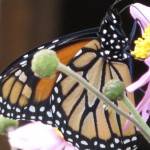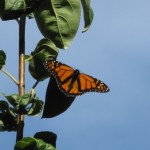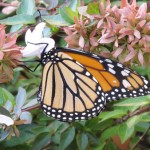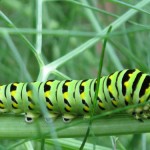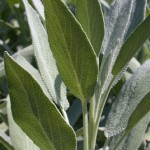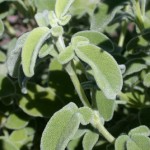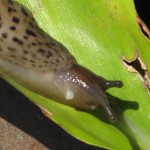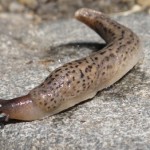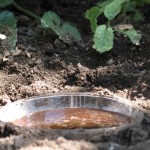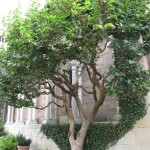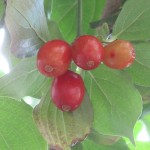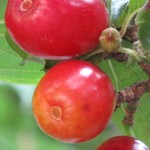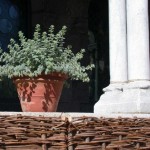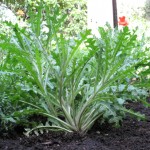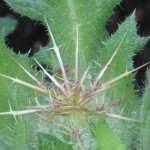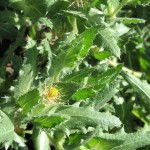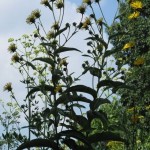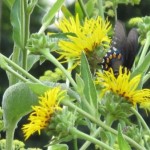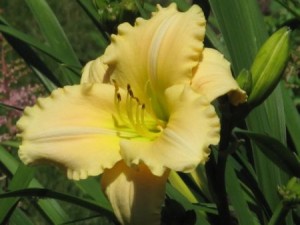Wednesday, October 6, 2010
The monarch is the most widely known and readily recognizable butterfly in the eastern United States. Between August and November each year, virtually the entire North American population of the species migrates to winter roosts in fir forests in the mountains of Mexico. Above, from left to right: Ventral view of an adult monarch feeding on a Japanese anemone in Cuxa garden; dorsal view of a male monarch hovering near a crabapple shoot; ventral view of a monarch feeding on a tubular flower of Abelia x grandiflora. Photographs by Corey Eilhardt.
The annual northern and southern migrations (see image) of the monarch (Danaus plexippus), the most beloved and familiar of North American butterflies, are monitored not only by professional lepidopterists, but also by many citizens and students across the country. In late summer and autumn, monarchs in the millions make for their ancestral wintering roosts in forests of oyamel fir trees (Abies religiosa) which grow??at heights of ten thousand feet in the Sierra Nevada mountains of Mexico. Read more »
Tags: Abelia grandiflora, Abies religiosa, butterfly, crabapple, Danaus plexippus, Lepidoptera, lepidopterist, Mexico, migration, monarch, Nymphalidae, Papilionidae, Sierra Nevada
Posted by Deirdre Larkin on Wednesday, October 6 at 12:35 pm | Comments (2)
Friday, September 24, 2010
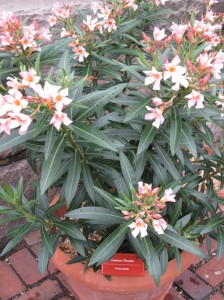
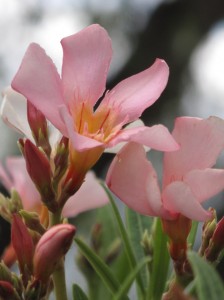
Above, from left to right: Nerium oleander, a tender evergreen shrub native to the Mediterranean, is grown in pots at The Cloisters and brought indoors for the winter. Oleander belongs to the Apocynaceae, or Dogbane family, which contains many poisonous species. The five petals of the oleander flower are fused at the base and form a tube; the form of the flower is typical of this botanical family. Photographs by Corey Eilhardt.
Nerion, which some call Rododaphne, some Rhododendron . . . grows in enclosed greens and sea-bordering places & in places near rivers. But ye flower and the leaves have a power destructive of dogs & of Asses & of Mules & and of most four-footed living creatures, but a preserving one of men, being drank with wine against the bitings of venemous beasts & ye more if you mixed it with Rue, but ye more weak sort of living creature, as goats & sheep, die, if they drink ye maceration of them.
???Dioscorides, De Materia Medica, Book IV, 82
Read more »
Tags: Apocynaceae, Dioscorides, Dogbane, Hortus Sanitatis, Nerium oleander
Posted by Deirdre Larkin on Friday, September 24 at 10:07 am | Comments (2)
Wednesday, September 15, 2010
The Black Swallowtail (Papilio polyxenes) butterfly is commonly found in fields, gardens, and open spaces in the Northeastern United States. Above, left: The body of the fully developed caterpillar with its bold, bright bands of yellow, green, and black, is conspicuous against the feathery foliage of the fennel which is its favorite food; center: a female Black Swallowtail at rest on a salvia in Cuxa garden, as seen from above; right: the same butterfly seen in profile with its wings folded upward. Photographs by Corey Eilhardt.
We found several large, boldly marked caterpillars feeding on a stand of fennel (Foeniculum vulgare) in Bonnefont garden last month. We left them undisturbed, knowing from past experience that they would grow up to be beautiful eastern Black Swallowtail butterflies. Read more »
Tags: Apiaceae, Black Swallowtail, caterpillar, Fennel, Foeniculum vulgare, furanocoumarins, osmeterium, Papilio polyxenes, photodermatitis, phytotoxins, Ruta graveolens
Posted by Deirdre Larkin on Wednesday, September 15 at 10:16 pm | Comments (1)
Tuesday, September 7, 2010
Sage, known by Latin epithets such as Salvia salvatrix, was a healing plant of great renown throughout the Middle Ages, although it was also valued as a culinary herb. Above, left: Salvia officinalis, the common garden sage, growing in a bed devoted to kitchen plants in Bonnefont garden; center: a detail from The Unicorn is Found, showing Salvia officinalis in flower; right: Greek sage or three-lobed sage (Salvia fruticosa) is not hardy in our climate, and is grown in pots and brought under cover in winter. The medicinal properties of this species were celebrated in antiquity and were conflated with those of S. officinalis.
Why should a man die in whose garden grows sage?
Against the power of death there is not medicine in our gardens
But Sage calms the nerves, takes away hand
Tremors, and helps cure fever.
Sage, castoreum, lavender, primrose,
Nasturtium, and athanasia cure paralytic parts of the body.
O sage the savior, of nature the conciliator!
???From Page Ten of the Regimen Sanitatis Salernitanum (A Salernitan Regimen of Health). See the Gode Cookery website to read the entire poem.
Cur moriatur homo cui salvia crescit in horto? (Why should a man die who has sage growing in his garden?) This much-quoted Latin adage is from the famous medieval didactic poem on maintaining good health, the Regimen Sanitatis Salernitanum. Read more »
Tags: culinary herb, Dioscorides, Gode cookery, rugose, sage, salvia fruticosa, salvia officinalis, salvia salvatrix, Theophrastus
Posted by Deirdre Larkin on Tuesday, September 7 at 1:54 pm | Comments (0)
Monday, August 23, 2010
Above, left: The great gray slug, also known as the leopard slug because of the spots and streaks on its mantle, at home in Bonnefont garden. These nocturnal garden pests are not normally seen during daylight hours. This specimen was spied early one morning, and posed to have his-her portrait taken (slugs are hermaphrodites). Center: When fully extended, the adult slug can reach an impressive length. Right: A single strategically placed slug trap baited with beer will attract quite a few slugs. Photographs by Corey Eilhardt.
The great gray slug (Limax maximus) is also commonly known as the leopard slug because of the characteristic dark spotting on the mantle which covers the upper part of its body; the lower part of its body, known as the foot, is often streaked or striped. Leopard slugs vary in color from brownish green to gray, with whitish undersides. Adult slugs range from 4 to 8 inches in length. Read more »
Tags: carnivore, clary sage, detrivore, gastropod, great gray slug, herbivore, leopard slug, Limax maximus, malacologist, mandrake, mollusc, pest, Salvia sclarea, slug, slug trap, stout
Posted by Deirdre Larkin on Monday, August 23 at 4:09 pm | Comments (1)
Friday, August 13, 2010
Above, from left to right: A mature cornelian cherry (Cornus mas) established against the east wall of Bonnefont garden; the foliage of Cornus mas is typical of the dogwood family to which it belongs; the tart red fruits, known as cornels, don’t ripen fully until after they fall from the tree in late July and early August. Photographs by Corey Eilhardt.
A native of dry, deciduous forests in central and southern Europe and western Asia, the cornelian cherry is a relative of our own flowering dogwood, Cornus florida. The fruit of the cornelian cherry is classified botanically as a drupe, as is the fruit of the true cherry, Prunus cerasus, but the two plants are in no way related. Although the fruits are unfamiliar to Americans, Cornus mas is very widely grown in this country as a small ornamental tree or as a multi-stemmed shrub, prized for the host of little yellow blossoms that veil the naked stems and branches in early March. Read more »
Tags: acorn, Alan Davidson, cherry, Circe, cornel, cornelian, Cornus florida, cornus mas, Dioscorides, drupe, Giacomo Castelvetro, Hildegard von Bingen, Homer, Hortus Sanitatis, kizilchik, Lee Reich, medlar, Prunus cerasus, quince
Posted by Deirdre Larkin on Friday, August 13 at 3:50 pm | Comments (5)
Friday, August 6, 2010
Above: The left and center image show the true or “right dittany” of Crete (Origanum dictamnus), a tender Mediterranean species grown in pots in Bonnefont garden. This pretty relative of the culinary oreganos is endemic to the island, and is found growing wild only in the mountains there. The small, purplish-pink flowers are borne on long-lasting bracts in late summer and fall. The image on the right shows Dictamnus albus, known as white dittany or fraxinella, which is a botanically unrelated species. Medieval herbalists seem to have transferred both the name and the??marvelous properties that the ancients ascribed to true dittany to this herb.
Origanum dictamnus, with its round, woolly gray leaves,??rosy??bracts and delicate purplish-pink flowers, is the prettiest of the tender medieval species grown in pots in Bonnefont garden, and the most difficult for us to grow. One of a number of species endemic to the mountains of Crete, the wild plant is only found growing in the crevices of limestone gorges and ravines (see image). Known as diktamnon in Greek, it is said to be named after Mount Dikti. Read more »
Tags: Aeneas, antidote, Aristotle, artemidon, Artemis, Bonnefont Garden, Cos, Crete, diktamnon, Dioscorides, Hellmut Baumann, Hippocrates, Mount Ida, Origanum dictamnus, snake, snakebite, Theophrastus, venom, Venus, Virgil, William Turner
Posted by Deirdre Larkin on Friday, August 6 at 8:35 am | Comments (1)
Friday, July 30, 2010
Above: Three images of the blessed thistle (Cnicus benedictus). The low stature and unremarkable appearance of this plant belie its medieval reputation as a plague cure and a panacea. The lax stems and spiny, light green leaves are covered with a fine, white down; the spines that subtend the developing flowerhead are a protection against grazing animals. The yellow flowers of this annual thistle appear in July; once the seeds have set, the plant dies. Photographs by Corey Eilhardt.
The humble Cnicus benedictus, a plant of waste ground and stony soil native to the Mediterranean, was a medieval panacea whose reputation survived undiminished into the Renaissance. The sixteenth-century English herbalist John Gerard notes that this wild medicinal plant of southern Europe was “diligently cherished in gardens in these Northern parts.” Gerard also attests that the herb was known everywhere in Europe by the medieval Latin name Carduus benedictus; the common names by which it is known today preserve this designation: blessed or holy thistle in English, benedikten distel in German; chardon b??nit or chardon santo in French, cardo benedetto in Italian, cardo bendito in Spanish.
Read more »
Tags: bitter, blessed thistle, Carduus benedictus, carline thistle, cataplasm, cnecos, Cnicus benedictus, Dioscorides, earbes Carduus Benedictus and Angelica, invasive, John Gerard, Maude Grieve, panacea, pestilence, plague, Pliny, Rufinus, Silybum marianum, thistle, Thomas Brasbridge, weed
Posted by Deirdre Larkin on Friday, July 30 at 4:02 pm | Comments (1)
Tuesday, July 13, 2010
Above, left: Elecampane growing in a bed in Bonnefont garden devoted to??medieval vegetables. The bright yellow flowers of this striking plant are borne high on tall stems that can reach an imposing height of six feet. Right: Detail of the fringed flowers, typical of the daisy family. Photographs by Corey Eilhardt.
The tall and showy elecampane (Inula helenium) is a striking presence along roadsides, in pastures, and on waste grounds both in Europe and in the United States, where it is considered an invasive weed by the U.S.D.A., especially in the moist and shady situations it prefers. It is nevertheless still widely planted in ornamental gardens for its imposing height, bold foliage, and bright yellow flowers, which come into bloom at midsummer. Read more »
Tags: aromatic, daisy, elecampane, inula helenium, inulin, invasive, John Gerard, ornamental
Posted by Deirdre Larkin on Tuesday, July 13 at 10:00 am | Comments (1)
Monday, July 5, 2010
Above, left: Jane Hayward in Cuxa garden on July 5, 1993. Jane happily wears a crown of daylilies for the ceremonial planting of a??newly introduced cultivar??named for her that year. Right: Detail of Hemerocallis ‘Jane Hayward’ now blooming in Cuxa garden.
In 1993, Jane Hayward, a curator for the department of Medieval Art and The Cloisters, and an authority on stained glass, had recently celebrated her twenty-fifth anniversary working at the Museum. As passionately devoted to medieval art and to The Cloisters as she was, Jane also had a passion for daylilies,??declaring that??her idea of immortality would be to have a daylily named after her. Read more »
Tags: daylily, Jane Hayward
Posted by Deirdre Larkin on Monday, July 5 at 10:00 am | Comments (12)
